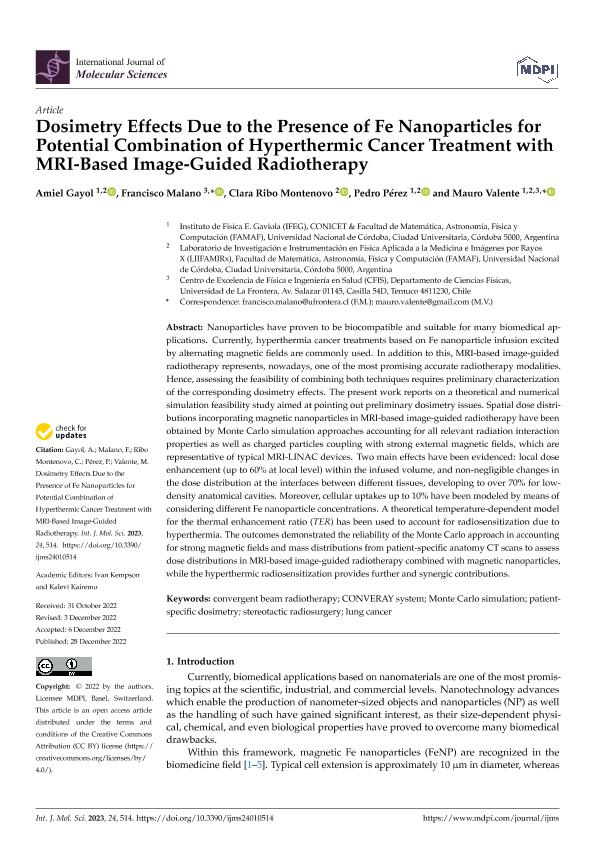Mostrar el registro sencillo del ítem
dc.contributor.author
Gayol, Amiel Rocio

dc.contributor.author
Malano, Francisco Mauricio

dc.contributor.author
Ribo Montenovo, Clara
dc.contributor.author
Pérez, Pedro Antonio

dc.contributor.author
Valente, Mauro Andres

dc.date.available
2023-08-08T11:11:41Z
dc.date.issued
2022-12-28
dc.identifier.citation
Gayol, Amiel Rocio; Malano, Francisco Mauricio; Ribo Montenovo, Clara; Pérez, Pedro Antonio; Valente, Mauro Andres; Dosimetry Effects Due to the Presence of Fe Nanoparticles for Potential Combination of Hyperthermic Cancer Treatment with MRI-Based Image-Guided Radiotherapy; MDPI; International Journal of Molecular Sciences; 24; 1; 28-12-2022; 1-21
dc.identifier.issn
1661-6596
dc.identifier.uri
http://hdl.handle.net/11336/207289
dc.description.abstract
Nanoparticles have proven to be biocompatible and suitable for many biomedical applications. Currently, hyperthermia cancer treatments based on Fe nanoparticle infusion excited by alternating magnetic fields are commonly used. In addition to this, MRI-based image-guided radiotherapy represents, nowadays, one of the most promising accurate radiotherapy modalities. Hence, assessing the feasibility of combining both techniques requires preliminary characterization of the corresponding dosimetry effects. The present work reports on a theoretical and numerical simulation feasibility study aimed at pointing out preliminary dosimetry issues. Spatial dose distributions incorporating magnetic nanoparticles in MRI-based image-guided radiotherapy have been obtained by Monte Carlo simulation approaches accounting for all relevant radiation interaction properties as well as charged particles coupling with strong external magnetic fields, which are representative of typical MRI-LINAC devices. Two main effects have been evidenced: local dose enhancement (up to 60% at local level) within the infused volume, and non-negligible changes in the dose distribution at the interfaces between different tissues, developing to over 70% for low-density anatomical cavities. Moreover, cellular uptakes up to 10% have been modeled by means of considering different Fe nanoparticle concentrations. A theoretical temperature-dependent model for the thermal enhancement ratio (TER) has been used to account for radiosensitization due to hyperthermia. The outcomes demonstrated the reliability of the Monte Carlo approach in accounting for strong magnetic fields and mass distributions from patient-specific anatomy CT scans to assess dose distributions in MRI-based image-guided radiotherapy combined with magnetic nanoparticles, while the hyperthermic radiosensitization provides further and synergic contributions.
dc.format
application/pdf
dc.language.iso
eng
dc.publisher
MDPI
dc.rights
info:eu-repo/semantics/openAccess
dc.rights.uri
https://creativecommons.org/licenses/by/2.5/ar/
dc.subject
CONVERAY SYSTEM
dc.subject
CONVERGENT BEAM RADIOTHERAPY
dc.subject
LUNG CANCER
dc.subject
MONTE CARLO SIMULATION
dc.subject
PATIENT-SPECIFIC DOSIMETRY
dc.subject
STEREOTACTIC RADIOSURGERY
dc.subject.classification
Otras Ciencias Físicas

dc.subject.classification
Ciencias Físicas

dc.subject.classification
CIENCIAS NATURALES Y EXACTAS

dc.title
Dosimetry Effects Due to the Presence of Fe Nanoparticles for Potential Combination of Hyperthermic Cancer Treatment with MRI-Based Image-Guided Radiotherapy
dc.type
info:eu-repo/semantics/article
dc.type
info:ar-repo/semantics/artículo
dc.type
info:eu-repo/semantics/publishedVersion
dc.date.updated
2023-07-07T21:27:39Z
dc.identifier.eissn
1422-0067
dc.journal.volume
24
dc.journal.number
1
dc.journal.pagination
1-21
dc.journal.pais
Suiza

dc.description.fil
Fil: Gayol, Amiel Rocio. Universidad Nacional de Córdoba. Facultad de Matemática, Astronomía y Física; Argentina. Consejo Nacional de Investigaciones Científicas y Técnicas. Centro Científico Tecnológico Conicet - Córdoba. Instituto de Física Enrique Gaviola. Universidad Nacional de Córdoba. Instituto de Física Enrique Gaviola; Argentina
dc.description.fil
Fil: Malano, Francisco Mauricio. Consejo Nacional de Investigaciones Científicas y Técnicas. Centro Científico Tecnológico Conicet - Córdoba. Instituto de Física Enrique Gaviola. Universidad Nacional de Córdoba. Instituto de Física Enrique Gaviola; Argentina. Universidad de La Frontera; Chile
dc.description.fil
Fil: Ribo Montenovo, Clara. Universidad de La Frontera; Chile
dc.description.fil
Fil: Pérez, Pedro Antonio. Universidad Nacional de Córdoba. Facultad de Matemática, Astronomía y Física; Argentina. Consejo Nacional de Investigaciones Científicas y Técnicas. Centro Científico Tecnológico Conicet - Córdoba. Instituto de Física Enrique Gaviola. Universidad Nacional de Córdoba. Instituto de Física Enrique Gaviola; Argentina
dc.description.fil
Fil: Valente, Mauro Andres. Consejo Nacional de Investigaciones Científicas y Técnicas. Centro Científico Tecnológico Conicet - Córdoba. Instituto de Física Enrique Gaviola. Universidad Nacional de Córdoba. Instituto de Física Enrique Gaviola; Argentina. Universidad Nacional de Córdoba. Facultad de Matemática, Astronomía y Física; Argentina. Universidad de La Frontera; Chile
dc.journal.title
International Journal of Molecular Sciences
dc.relation.alternativeid
info:eu-repo/semantics/altIdentifier/url/https://www.mdpi.com/1422-0067/24/1/514
dc.relation.alternativeid
info:eu-repo/semantics/altIdentifier/doi/http://dx.doi.org/10.3390/ijms24010514
Archivos asociados
